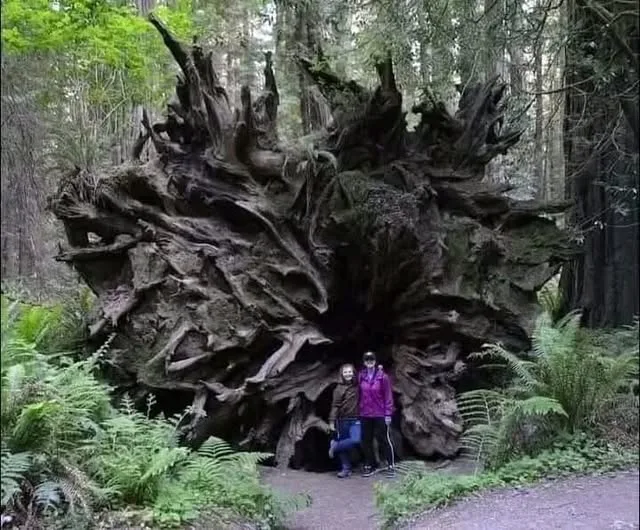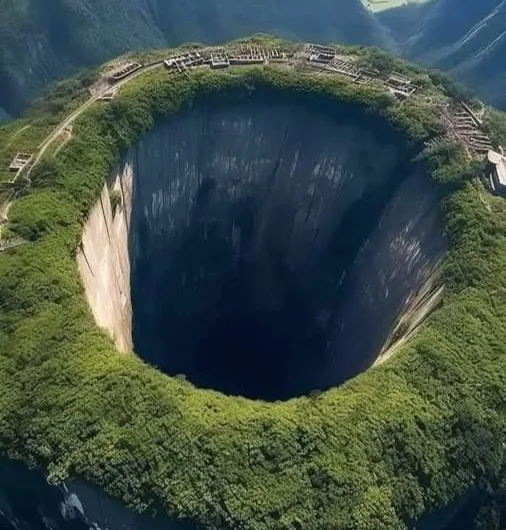
2,000 year old human torso of an Irish man that was found in a bog back in June of 2003.
The remains were naturally mummified and preserved so well that scientists were able to even determine his last meal after analyzing the contents of his stomach: wheat and buttermilk. For at least 4 months prior to his death, he was shown to have a meat rich diet. Based on the length of his arms, he was estimated to have been 6 ft 6 inches (1.98 m) tall which would have been extremely tall for that time period.
According to Oxford University, the average male height around this time was around 165 cm (5 feet 5 inches).
The man also had manicured nails which has led to speculation that he was not engaged in manual labor and was someone of high status. His body is currently on display at the National Museum of Ireland in Dublin.

Old Croghan Man: A 2,000-Year-Old Irish Giant Preserved in a Bog
Discovered in June 2003 in a peat bog near Croghan Hill, County Offaly, Ireland, the Old Croghan Man is a remarkably preserved 2,000-year-old human torso from the Iron Age (c. 362–175 BCE). Naturally mummified by the bog’s acidic, oxygen-poor environment, this partial body—lacking head, lower limbs, and one arm—offers a vivid glimpse into ancient Celtic life. Standing an estimated 6 feet 6 inches (1.98 m) tall, with manicured nails and a diet rich in meat, wheat, and buttermilk, Old Croghan Man was likely a high-status individual. Now displayed at the National Museum of Ireland in Dublin, his remains reveal details about his life, death, and the society he inhabited.
Discovery and Preservation
Found by workers draining a bog near Croghan Hill, Old Croghan Man was excavated by archaeologists from the National Museum of Ireland. The bog’s unique conditions—low oxygen, high acidity, and cold temperatures—acted as a natural preservative, mummifying his skin, muscles, and internal organs. Key preservation details:
Condition: The torso, upper arms, and hands are intact, with leathery but flexible skin. The absence of head and lower limbs suggests deliberate dismemberment or post-mortem damage during peat cutting.
Dating: Radiocarbon dating places his death between 362 and 175 BCE, during Ireland’s Late Iron Age, aligning with the La Tène culture of Celtic Europe.
Comparison: Discovered months before Clonycavan Man, another Irish bog body, Old Croghan Man is part of a cluster of over 120 bog bodies found in Ireland, though few are as well-preserved.
The bog’s tannic acids stained his skin dark brown, but details like fingerprints and nail beds remain pristine, enabling precise analysis.
Physical Characteristics and Status
Old Croghan Man’s remains provide clues to his appearance and social standing:
Height: Estimated at 6 feet 6 inches (1.98 m) based on arm length and torso proportions, he towered over contemporaries. Oxford University data cites an average male height of 165 cm (5 feet 5 inches) in Iron Age Europe, making him exceptionally tall—possibly a genetic outlier or a result of superior nutrition.
Manicured Nails: His hands show smooth, well-groomed nails, suggesting he avoided manual labor. Archaeologists interpret this as evidence of high status, possibly as a chieftain, priest, or elite warrior. In Celtic society, such grooming was associated with nobility.
Physical Build: His long, muscular arms indicate a robust physique, despite no evidence of heavy labor. Scars and wear on his hands suggest some physical activity, perhaps combat or ritualistic roles.
Age: Analysis of bone growth and tissue suggests he was in his late teens to mid-20s at death, young for such prominence.
His towering stature and refined appearance likely made him a striking figure, reinforcing his elite status in a society where physical presence signified power.
Diet and Lifestyle
Analysis of his stomach contents and isotopic signatures in his tissues paints a picture of his diet:
Last Meal: His stomach contained traces of wheat (possibly bread or porridge) and buttermilk, a common Iron Age meal. This suggests a ritualistic or everyday diet, consumed shortly before death.
Long-Term Diet: Stable isotope analysis of his hair and nails indicates a meat-rich diet for at least four months prior to death, high in animal protein (likely beef or pork). This contrasts with the typical Iron Age diet of grains, dairy, and occasional meat, further supporting his elite status, as meat was a luxury.
Seasonal Context: The presence of dairy and absence of summer fruits suggest he died in late winter or early spring (February–April), aligning with Celtic festivals like Imbolc.
His access to abundant meat underscores the social hierarchy of Iron Age Ireland, where elites controlled livestock and feasted to display wealth.
Cause of Death: A Ritual Sacrifice?
Old Croghan Man’s death was violent, with evidence pointing to ritual sacrifice, a practice documented in Celtic cultures by Roman sources like Tacitus and Strabo:
Injuries:
Stab Wounds: Deep cuts to his chest and abdomen, likely from a blade, caused fatal internal damage.
Defensive Wounds: Marks on his arm suggest he tried to fend off an attack.
Nipple Mutilation: His nipples were pinched or cut, possibly symbolic, as suckling a king’s nipples was a Celtic gesture of submission. Damaging them may have ritually disqualified him from kingship.
Binding: Holes in his upper arms held hazel withies (flexible branches), indicating he was tied or staked to the bog, possibly alive or post-mortem.
Dismemberment: The missing head and lower limbs may reflect deliberate disarticulation, a Celtic practice to prevent the dead from returning or to distribute body parts as offerings. Alternatively, peat-cutting machinery in 2003 could have caused the loss.
Bog Deposition: Bogs were sacred to the Celts, seen as liminal spaces to the underworld. Depositing bodies in bogs, often with objects like butter or torcs, was a votive act, possibly to appease deities or mark territorial boundaries.
Archaeologists, including Ned Kelly of the National Museum, propose Old Croghan Man was a sacrificed king or high-status figure, killed during a crisis (e.g., crop failure or political instability) to restore balance. His youth and stature suggest he was chosen for his symbolic potency, a practice echoed in other bog bodies like Lindow Man (England) and Tollund Man (Denmark).
Cultural and Historical Context
Old Croghan Man lived during Ireland’s Iron Age, a time of tribal kingdoms, druidic religion, and vibrant Celtic art:
Society: Ireland was divided into tuatha (petty kingdoms), led by warrior-elites and druids. Sites like Croghan Hill, near the find, were ceremonial centers, possibly linked to royal inaugurations. The Rathcroghan complex in Connacht, associated with the epic Táin Bó Cúailnge, reflects similar traditions.
Ritual Landscape: The bog’s proximity to ancient trackways and hillforts suggests it was a sacred boundary, used for offerings. Over 40 bog bodies in Ireland align with such sites, supporting the ritual hypothesis.
Global Connections: The La Tène culture linked Ireland to Europe, with parallels in bog sacrifices from Denmark to Germany. Old Croghan Man’s death mirrors practices described in the Gundestrup Cauldron (Denmark, c. 150 BCE), depicting ritual killings.
His sacrifice may have been a response to social or environmental stress, a practice that waned with Christianity’s rise by the 5th century CE.
Display and Public Interest
Old Croghan Man is exhibited at the National Museum of Ireland – Archaeology in Dublin, in the Kingship and Sacrifice gallery, alongside Clonycavan Man and other bog bodies:
Exhibit Details: The torso is displayed in a climate-controlled case to preserve its delicate tissues. Panels explain his diet, injuries, and cultural context, with replicas of his hands showcasing the manicured nails. A 2006 documentary, Kings of the Bogs, details the find.
Visitor Info:
Location: Kildare Street, Dublin 2.
Admission: Free, open daily (10 AM–5 PM, 1 PM–5 PM Sundays, 2025).
Tips: Combine with the museum’s Ardagh Chalice and Tara Brooch exhibits. Photography is allowed (no flash). Guided tours (~€5) offer deeper insights.
Public Reaction: The exhibit draws 500,000 visitors annually (2024), with X posts praising its eerie realism: “Old Croghan Man’s hands look like they could still move—creepy but amazing,” one user wrote. Others marvel at his height: “6’6” in 200 BCE? He’d be an NBA star today!”
Scientific and Cultural Significance
Old Croghan Man is a time capsule of Iron Age Ireland:
Scientific Value: His preservation enables DNA analysis (ongoing, limited by bog degradation), isotopic studies, and paleopathology, revealing diet, health, and mobility. A 2014 study in Antiquity confirmed his high-protein diet, while CT scans show no chronic diseases, suggesting a healthy life before his violent end.
Cultural Insight: He illuminates Celtic kingship rituals, where leaders were both revered and expendable. The nipple mutilation and bog deposition align with myths in texts like the Lebor Gabála Érenn, linking sacrifice to sovereignty.
Modern Relevance: The find fuels debates on ritual violence and human sacrifice, challenging romanticized views of Celtic culture. It also highlights bog conservation, as peat extraction threatens undiscovered remains (Ireland banned commercial peat cutting in 2021).
Clarifications
Height Estimate: The 6 feet 6 inches estimate is based on arm-to-torso ratios, as no legs survive. While precise, it assumes average proportions, so 6’4”–6’8” is possible. His height remains exceptional for the era.
Diet Timeline: The “four months” of meat consumption reflects hair and nail growth rates, which record isotopic signatures. His last meal (wheat, buttermilk) was likely consumed hours before death.
Status Speculation: Manicured nails suggest high status, but he could have been a ritual specialist or hostage, not necessarily a king. Celtic elites often avoided labor, per Roman accounts like Diodorus Siculus.
Dismemberment: The missing head may reflect a Celtic practice of headhunting or trophy-taking, though bog damage can’t be ruled out.
Why Old Croghan Man Matters
Old Croghan Man is more than a relic—he’s a window into a world of Celtic ritual, social hierarchy, and human drama. His 6-foot-6 stature, manicured nails, and meat-rich diet paint a portrait of an Iron Age elite, possibly sacrificed to appease gods or secure his tribe’s future. The bog’s preservation—down to his last meal of wheat and buttermilk—offers an intimate connection to 200 BCE, a time when Ireland’s kings walked bogs and hills. At Dublin’s National Museum, his torso evokes awe and unease, a 2,000-year-old giant whose story still resonates.
X users capture the fascination: “Old Croghan Man was a literal giant—imagine him striding through ancient Ireland,” one posted. For archaeologists, he’s a key to unlocking Celtic mysteries; for visitors, he’s a haunting encounter with humanity’s past. As Ireland’s bogs yield more secrets, Old Croghan Man stands tall—literally and figuratively—as a testament to our shared history.


